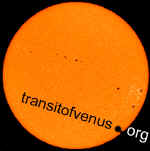In preparation for the 1882 transit of Venus expeditions, the United States Naval Observatory printed a publication listing the detailed duties of each member of the expedition team. Based on the experiences of the 1874 expeditions eight years prior, the book explains what the observer may expect to see and how to discern the instant of contact. The excerpts below may be useful for 21st century observers, though modern efforts cannot expect to sidestep the difficulties of getting an accurate timing.
 |
 |
 |
 |
 |
 |
 |
| instructions39.gif | instructions40.gif | instructions41.gif | instructions42.gif | instructions43.gif | instructions44.gif | instructions45.gif |
Thanks to Robert Havlik for finding this publication in the John Crerar Library, Chicago.
Peter Broughton writes at http://www.rasc.ca/historical/transit.pdf:
"For everyone hoping to see the transit on June 8, 2004, there are certainly lessons to be learned from the past. Those who wish to time the contacts would be well advise to practise ahead of time with computer simulations and to be well aware of the different states that might be observed near internal contact such as the halo that surrounds the planet before, and the formation and breaking of a dark thread after contact. Even with such modern trappings as radio-time signals, video and digital recording, can any observers time the contacts better than their forebears of the nineteenth or even the eighteenth century?"
![]() http://home.hetnet.nl/%7Esmvanroode/venustransit/eng/eng_parallax.html#BD
http://home.hetnet.nl/%7Esmvanroode/venustransit/eng/eng_parallax.html#BD
At the critical moment when observers try to time when Venus touches the
inside edge of the sun, strange phenomena such as the black
drop effect suddenly emerge. This site guides observers in discerning
at what instant internal contact occurs; from Steven van Roode.

